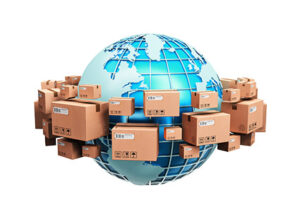Table of Contents:
- What is the USMCA?
- e-Commerce Shipments
- Stronger Border Enforcement
- Helping Small Business Grow
USMCA & eCommerce: Outlook for 2021
The volume of imports to USMCA countries continue to rise with new provisions that improve cross-border trade participation and protection for intellectual property rights, the workforce and the environment, among others. However, customs agencies and traders must deal with new challenges effectively in order to fully leverage USMCA benefits. Read on to learn more about USMCA & eCommerce: Outlook for 2021.
What is the USMCA?
The USMCA or U.S.–Mexico–Canada Agreement is a trade deal between the three countries. The USMCA went into effect on July 1, 2020 and replaced the old North American Free Trade Agreement (NAFTA). Six years after enforcement, the USMCA will require a joint review of operations and recommendations for actions, meaning that nothing is set in stone and the trade community should expect policy changes.
The USMCA has a major impact on the automotive industry, with new rules of origin criteria for automotive and automotive part imports, including higher regional value content, new labor value content, and new steel and aluminum import requirements. Importers should pay close attention to these requirements to ensure compliance.
Other affected industries are textile and apparel, goods manufacturing, and agricultural manufacturing.
For agricultural goods, the USMCA retains the zero-tariff treatment under NAFTA but adjusted tariff rate quotas to give the U.S. more access to Canada’s dairy and poultry markets.
Other key changes:
- Prohibits duties on digital products like e-books, music, videos, software and games.
- Prevent unnecessary restrictions on imported remanufactured goods. If one party maintains a prohibition/restriction on a used good, it must not apply this rule to a remanufactured good.
- Provisions to fight illegal procurement of wild flora (including timber) and fauna, evasion of antidumping/countervailing duties, imports of goods sourced from forced labor, and transshipments of goods that infringe intellectual property rights.
- Limit data localization requirements and reduce red tape through a searchable knowledge base of laws, regulations, tariffs, and other customs information.
- U.S. Customs and Border Protection (CBP) has developed new tools to improve analysis, investigations, data sharing, and site visits.
e-Commerce Shipments
USMCA enforcement means changes for the ecommerce industry, mainly in the form of increased de minimis values for Mexico and Canada designed to encourage more balanced trade among the three countries. Mexico will continue to provide tax-free de minimis shipments up to $50 and duty-free shipments not exceeding $117. Meanwhile, Canada will provide duty-free shipments for goods valued at a maximum of C$150, and for the first time in years, raise its de minimis value from C$20 to C$40 but only applicable for shipments that are imported from Mexico and the United States.
Low-value shipments (Section 321) and express shipments valued at $2,500 and below can enter USMCA countries with minimal entry requirements— a great boost to small and midsize businesses that wish to enter the USMCA ecommerce market. Businesses, including freight forwarders, handling agents, logistics providers, and transport operators, directly benefit from the reduced cost of ecommerce and access to more customers.
USMCA Outlook for Q3 & Q4 2021: Stronger Border Enforcement
Phase I implementation of the USMCA ended on December 31, 2020, which means stronger enforcement of regulations by CBP going forward. Phase I allowed the U.S. trading community time to adjust to the new changes, including allowing automotive certifications to meet documentation requirements.
The end of Phase I will likely mean more formal audits for USMCA transactions, with CBP checking the validity of claims and certifications. This could lead to possible financial penalties and other fees for noncompliant businesses. If you haven’t done so already, this is the time to review your criteria for certifying goods covered by the USMCA. Automotive companies in particular should pay closer attention to their USMCA certifications this year.
For ocean freight, the Federal Maritime Commission (FMC) has been investigating the detention and demurrage processes of ocean carriers that call at certain ports in the U.S. to check whether these practices are legal or not. Any business involved in ocean transport and logistics should prepare for more scrutiny as marine imports continue to rise.
Potential Changes Under the Biden Administration
The Biden admin plans to prioritize trade negotiations with traditional partners like the EU, but the President said he aims to focus on new investments in the U.S. before entering new trade deals. Another potential priority is coordinating with partner countries to deal with trade challenges from countries like China.
While industry experts believe there is no incentive for the Biden administration to make changes to the USMCA, customs modernization is another matter. The 1993 Mod Act improved CBP’s enforcement capabilities and entry automation processes, but rapid changes in technology, security risks, and global trade require new legislation to meet the needs of traders and government agencies.
CBP has been keeping up with changes like the ecommerce boom, intellectual property issues, and goods sourced from forced labor, but the agency could do more to address challenges. With USMCA enforcement, CBP is looking to implement new shipment and origin data requirements for imports. Traders should expect more data requirements in the future, including at the production and sourcing level.
Part of the USMCA provisions for labor is stronger enforcement and monitoring of labor practices at certain facilities. CBP has started to crack down on Chinese imports suspected to be produced with forced labor, and the agency has targeted both direct imports and countries with possible illegal transshipments.
Legislation to allow CBP to stop imports from China’s Xinjiang Uighur Autonomous Region (XUAR) and require more visibility into the importer’s supply chain is currently under review. Meantime, CBP is banning imports aggressively at the border with a focus on China and the XUAR, and conducting mini audits on importers and countries suspected of transshipments. If a forced labor compliance program becomes mandatory, participants in the Custom Trade Partnership Against Terrorism (C-TPAT) program would require processes to ensure that imports were not produced with forced labor.
The USMCA has benefited ecommerce participants including SMEs, but the revamped trade deal has led to increased scrutiny on imports and the supply chain, especially imports from China. CBP will continue to monitor imports and importers for noncompliance, and traders should expect increased data requirements for certain goods. Importers of finished goods, raw materials and components are urged to work with their suppliers to check supply chains for the risk of forced labor and ensure compliance with the new regulations.
Helping Small Business Grow

CrimsonLogic helps businesses maximize the benefits of cross-border trade under the USMCA while optimizing compliance with trade regulations.
CrimsonLogic enables the orchestration of physical logistics, compliance and financial requirements of trade and supply chain seamlessly, smartly and securely, thus powering global trade by making it accessible, predictable and easier to fulfil.
To learn more, visit our page on USMCA & eCommerce or contact us today!


